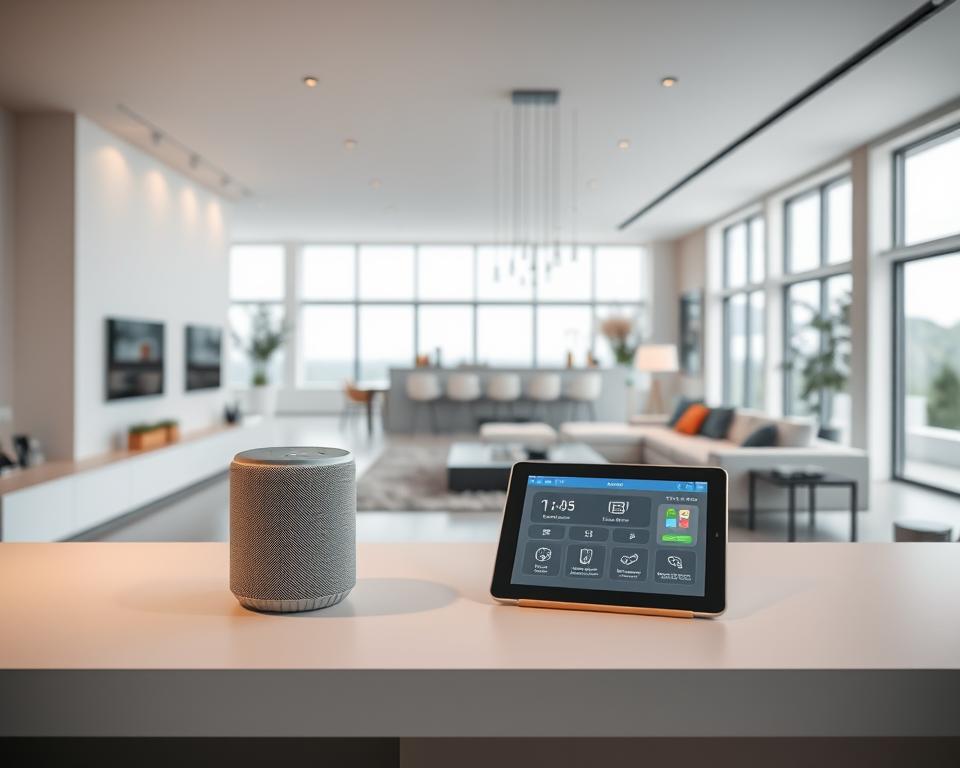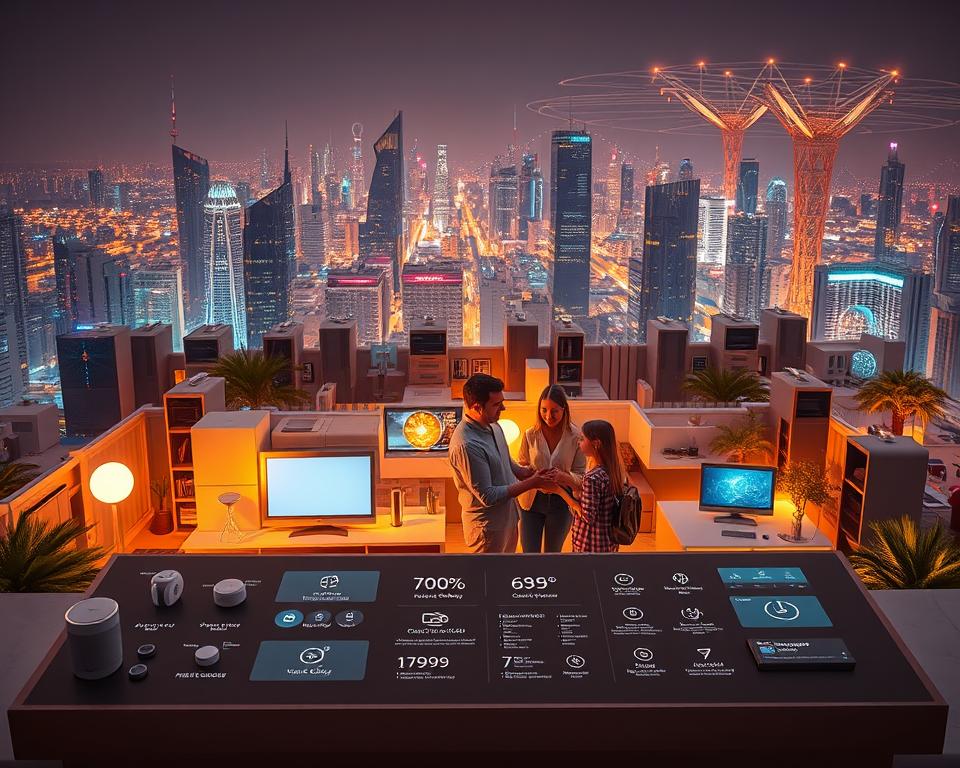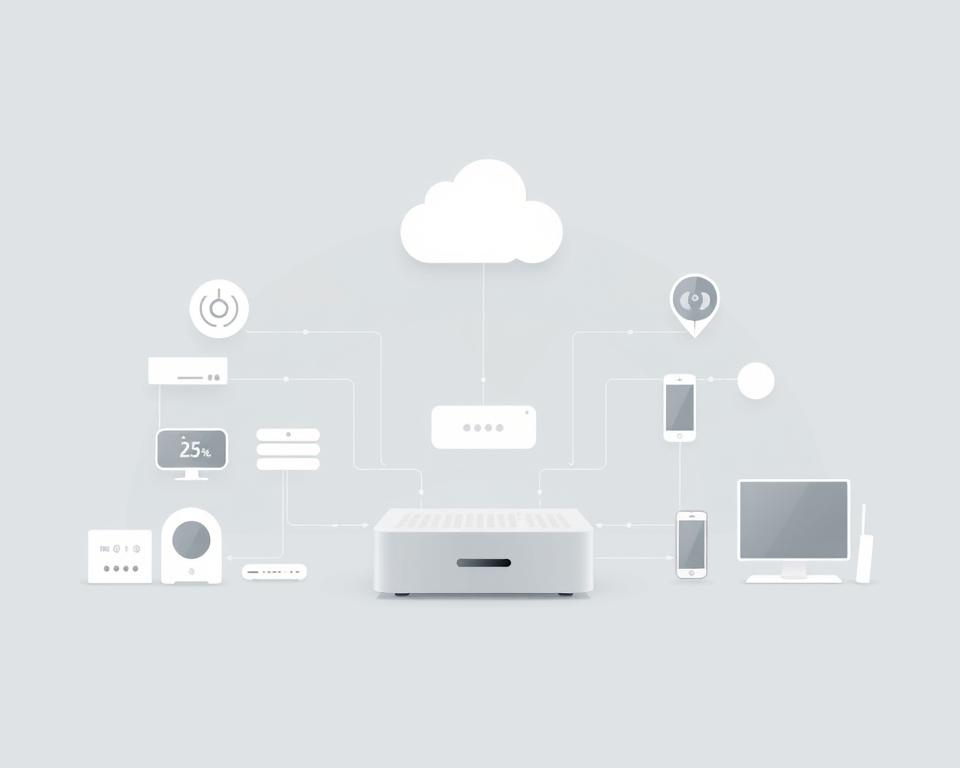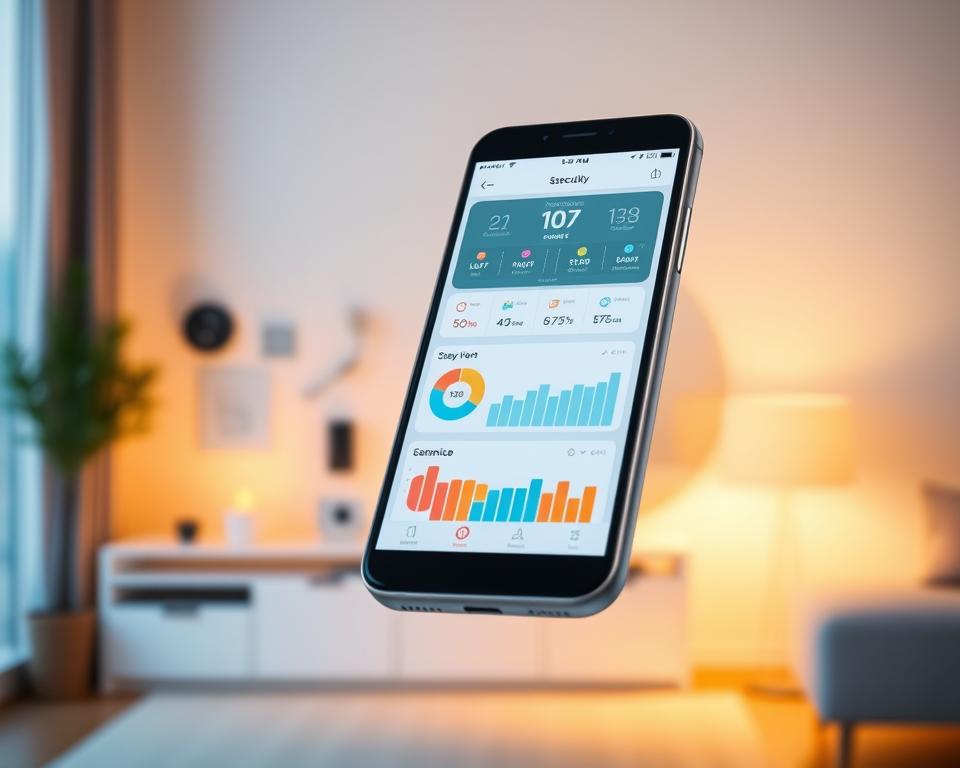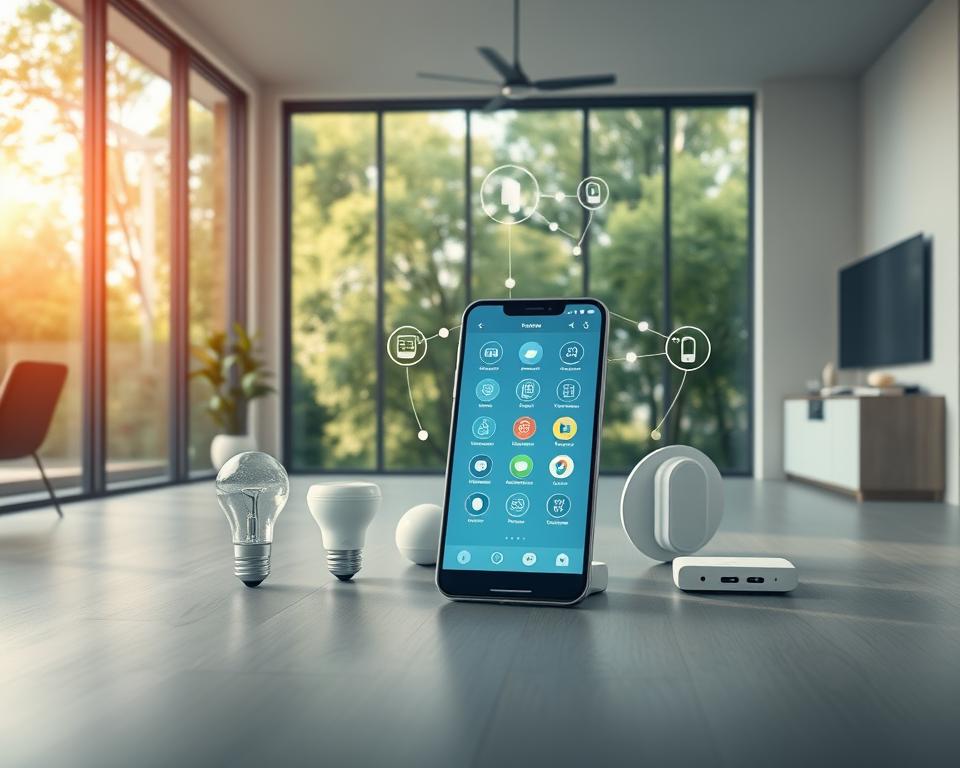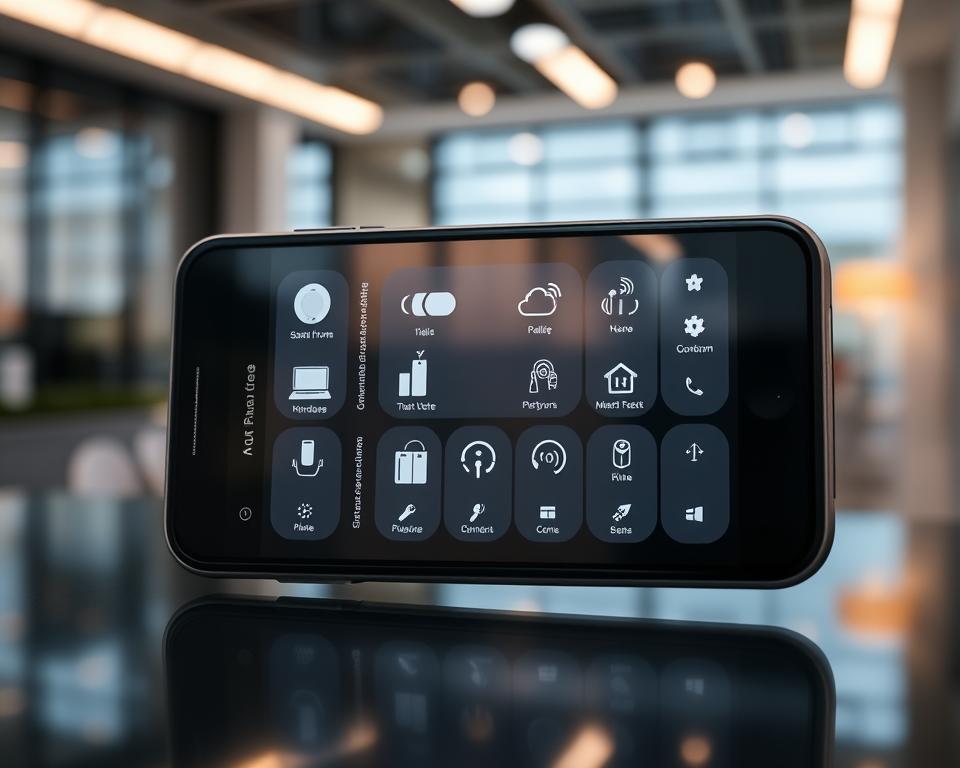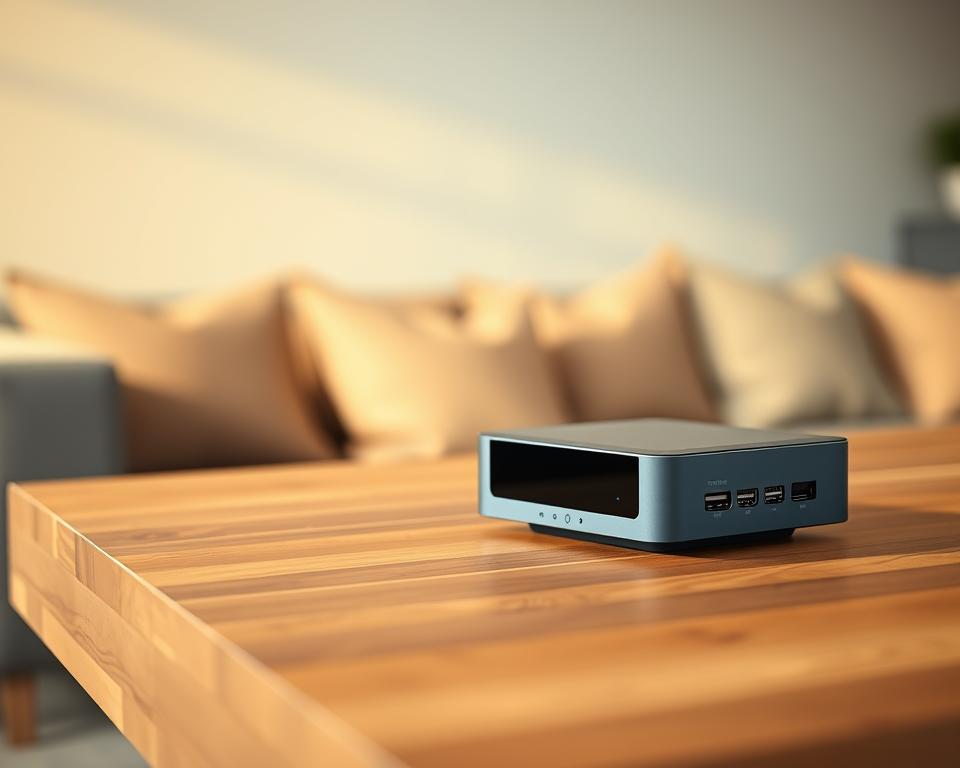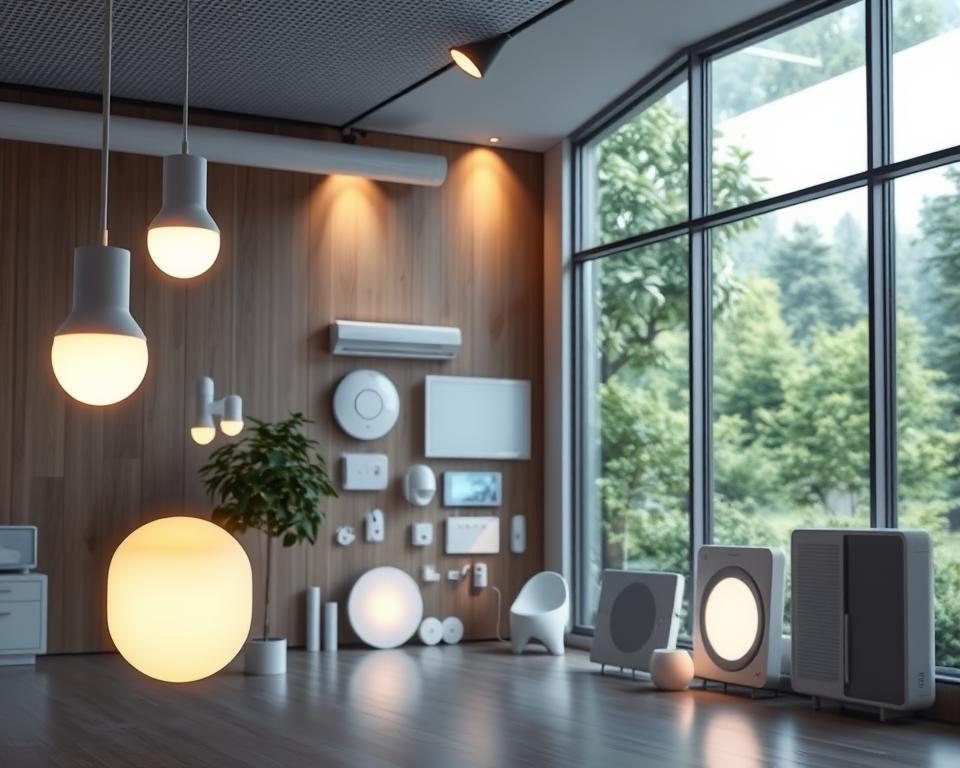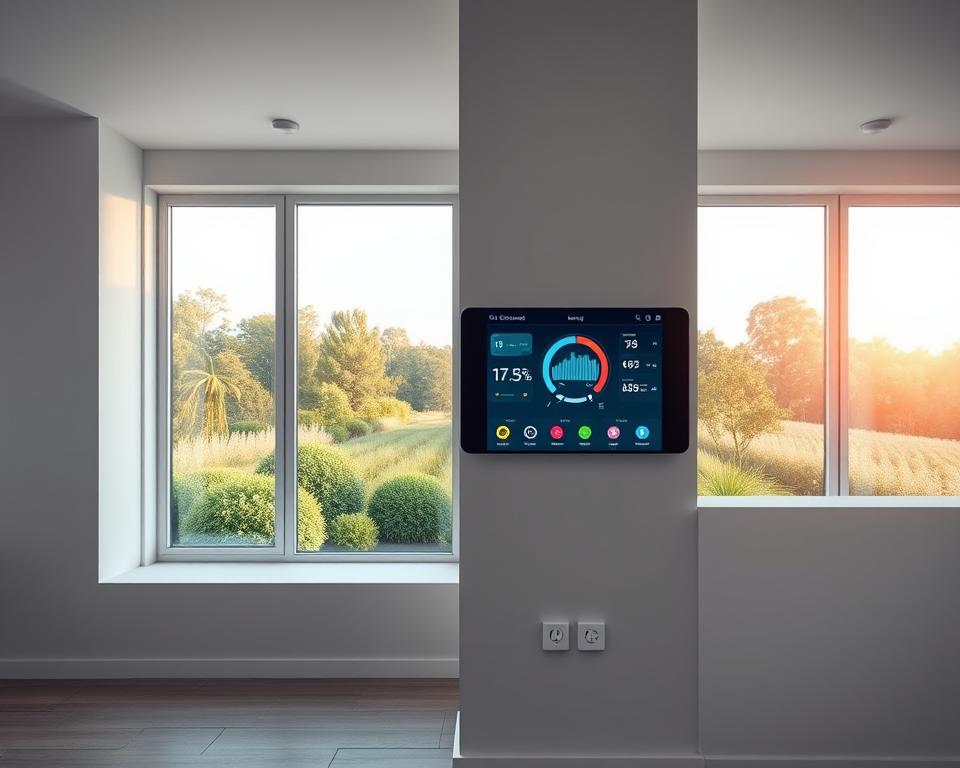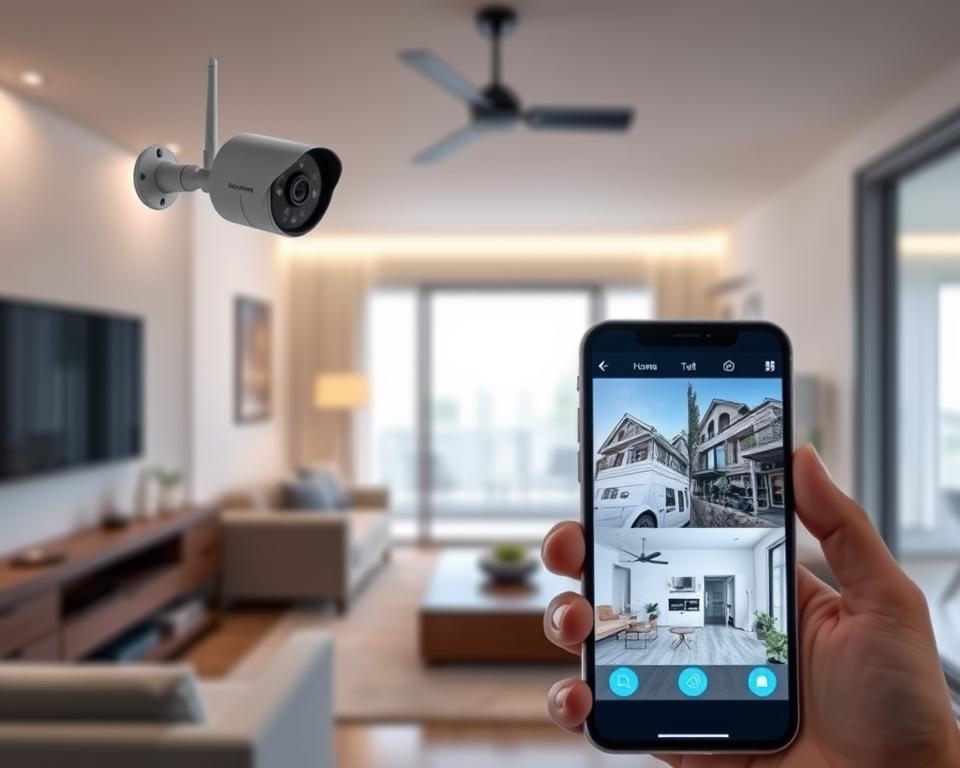The mix of Smart Home Technology and mobile apps is changing how we live. It makes our homes smarter and more connected.
Thanks to Connected Devices, we can now control and watch our homes from anywhere. This boosts convenience, security, and saves energy.
The blend of IoT and mobile apps makes devices talk to each other easily. This leads to a more automated and smooth living experience.
As we look ahead, combining these technologies will become even more crucial. It will change what we think of as home and living.
Table of Contents
Key Takeaways
- Smart Home Technology is transforming homes into intelligent, connected spaces.
- The integration of IoT and mobile apps enhances convenience, security, and energy efficiency.
- Connected Devices allow for remote control and monitoring of living spaces.
- The convergence of IoT and mobile apps streamlines and automates the living experience.
- The future of home living will be heavily influenced by these technologies.
The Evolution of Smart Home Technology
Smart homes have changed a lot over time. They’ve moved from simple automation to complex systems. This change is thanks to new tech, how people live, and the need for ease, safety, and saving energy.
From Simple Automation to Intelligent Ecosystems
At first, smart homes just controlled lights and temperature. But with Internet of Things (IoT), they got much smarter. Now, they link many devices together. You can manage them all with mobile apps.
The Role of Mobile Apps in Smart Home Evolution
Mobile apps have been key in making smart homes better. They let you control your devices, get alerts, and check on your home’s energy use. These apps make living in a smart home easier and more fun.
As tech keeps getting better, we’ll see even more cool things with mobile apps. They’ll make our smart homes even more amazing.
Understanding IoT Architecture for Smart Homes
IoT architecture is key for smart homes. It combines devices, sensors, and software for a smart living space. This makes homes run smoothly and automatically.
Core Components of IoT Systems
The heart of IoT systems includes sensors and actuators. They collect data and act on it. Gateways and hubs connect devices and manage data. And cloud services offer remote access and data analysis. For more on smart home apps, check out Next Big Technology.
Communication Protocols in Smart Home Environments
Good communication is essential in IoT architecture. Protocols like Zigbee, Z-Wave, and Bluetooth help devices talk to each other and control centers. Experts say, “The right protocol can make smart homes work better and stay secure.”
“The future of smart homes depends on the seamless integration of devices and systems, enabled by robust IoT architecture.”
Edge Computing vs. Cloud Processing
Data processing in smart homes has two main ways: edge computing and cloud processing. Edge computing handles data locally, which is faster and more responsive. Cloud processing sends data to servers for analysis, offering more scalability.
Choosing between edge and cloud depends on the system’s needs. This includes data volume, processing needs, and security.
Mobile App Development for IoT Integration
Creating mobile apps for IoT needs a deep understanding of both mobile and IoT worlds. As IoT grows, app developers face new challenges and chances. They must adapt to the unique needs of connected devices.
Native vs. Cross-Platform Development Approaches
Choosing between native or cross-platform development is key for IoT apps. Native apps run smoothly and access device hardware directly, important for IoT’s real-time needs. Cross-platform apps, however, deploy faster across many platforms, saving time and money.
The right choice depends on the app’s needs. Native is better for apps needing intense processing or direct hardware access. But, for apps focusing on user experience, cross-platform might be the way to go.
Backend Requirements for IoT Applications
The backend of IoT apps is vital for handling data from devices, processing it, and sending back insights or commands. It must handle many connections, process data quickly, and keep data safe.
Scalability, security, and data handling are key for the backend. It needs to grow with more devices and data. Security, like encryption and secure login, is crucial to prevent unauthorized access.
API Design Considerations
API design is essential for IoT app development. It connects the app, servers, and devices. A good API is easy to use, secure, and grows with the app.
| API Design Element | Description | Importance |
|---|---|---|
| Security | Implementing robust security measures such as OAuth, encryption, and secure authentication | High |
| Scalability | Designing the API to handle an increasing number of requests and devices | High |
| Documentation | Providing clear, comprehensive documentation for developers | Medium |
| Versioning | Implementing API versioning to manage changes and updates | Medium |
By focusing on these areas, developers can make mobile apps that work well with IoT devices. These apps are robust, secure, and scalable for users.
IoT + Mobile Apps: Building Smart Homes and Connected Devices
The mix of IoT and mobile apps is making our homes more convenient, safe, and energy-saving. As we add more tech to our lives, the link between mobile apps and IoT gadgets is key. It shapes the smart homes we’ll have in the future.
The Synergy Between Mobile Interfaces and IoT Hardware
Mobile apps and IoT devices work together well. Apps let us control and check on IoT devices. Meanwhile, IoT devices give apps the data and features they need. This teamwork lets us manage lights, temperature, security, and fun stuff from anywhere, making our homes more connected.
Creating Seamless User Experiences
To make user experiences smooth, app makers focus on design, fast data handling, and strong security. They use edge computing and cloud processing to make data handling quick and safe. This cuts down on delays and boosts app performance.
Also, predictive analytics and machine learning algorithms help guess what we need. They automate tasks, making our smart homes better.
Balancing Local and Cloud Processing
One big challenge in making IoT-enabled apps is finding the right mix of local and cloud processing. Cloud processing is flexible and scalable, but local processing is needed for fast, real-time control. By finding the perfect balance, developers make apps that work well and can grow.
This balance is key for quick responses from smart home devices. It also lets the cloud handle data analysis and storage.
User Experience Design for IoT Mobile Applications
Good user experience design is key for successful IoT mobile apps. It makes controlling devices and automating tasks easier. These apps need to be easy to use, fast, and accessible for a smooth smart home experience.
Simplifying Complex Device Control
Designing IoT mobile apps is tough because of complex device control. Using intuitive icons and clear labeling helps make the app easy to understand. This way, users can handle their devices without getting confused.
Designing Intuitive Automation Interfaces
Automation is a big part of IoT devices, letting users set up custom routines. Designers should use drag-and-drop functionality and visual representations to make it easy. This lets users create complex rules without needing to know programming.
Accessibility Considerations for Diverse Users
It’s important for IoT mobile apps to be accessible to everyone. Designers should think about color contrast, font size, and screen reader compatibility. This makes the app usable for people with different abilities, creating a better experience for all.
Smart Home Hubs and Control Centers
In the world of smart homes, control centers and hubs are key. They help connect different IoT devices. This makes managing smart devices easy and creates a connected living space.
Centralized vs. Decentralized Control Systems
Smart home systems can be set up in two ways: centralized or decentralized. Centralized systems use one hub to control all devices. Decentralized systems spread control across many devices.
A centralized system is simple and easy to manage. But, it can fail if the hub goes down. Decentralized systems are more reliable but harder to manage.
Voice Assistants as Control Interfaces
Voice assistants are a popular way to control smart home devices. They let you control things like lights and security without using your hands. For more on IoT mobile apps, check out this guide.
Mobile Apps as Universal Remote Controls
Mobile apps are key for controlling smart homes. They act as universal remotes for many devices. They let you control your home from anywhere, with features like device control and monitoring.
| Control Method | Advantages | Disadvantages |
|---|---|---|
| Centralized Control | Simplified management, single interface | Vulnerable to single-point failures |
| Decentralized Control | Redundancy, resilience | Complex management, multiple interfaces |
| Voice Assistants | Hands-free, intuitive control | Limited functionality, dependent on voice recognition |
| Mobile Apps | Remote access, flexible control | Dependent on network connectivity, potential security risks |
Connected Lighting and Environmental Systems
Connected lighting systems are leading the way in making homes more energy-efficient and personalized. Smart technology in lighting lets homeowners control and customize their spaces like never before.
Smart Bulbs and Lighting Infrastructure
Smart bulbs are key in connected lighting. They can be controlled from your phone, changing brightness, color, and schedule. For more on smart home costs and features, check out Next Big Technology.
Scene Creation and Automation
Connected lighting lets you create your own scenes and automate lights. For example, a “good morning” scene can slowly brighten your lights like a sunrise. It’s a gentle way to wake up.
Energy Efficiency Through Mobile Monitoring
Mobile apps help track energy use in real-time. This makes it simple to spot where you can save energy. Using smart bulbs and systems can cut down on energy waste a lot.
With connected lighting and smart systems, homes become more eco-friendly, cozy, and high-tech.
Climate Control and Energy Management
Smart homes are getting better, focusing on climate control and energy management. These areas make homes comfortable and save energy. New technologies help homeowners use their heating, cooling, and energy wisely.
AI-Powered Temperature Management
AI systems learn what you like and adjust the temperature for you. This makes your home comfortable and saves energy. They also adjust to weather changes, making them even more efficient.
Geofencing and Presence Detection
Geofencing and presence detection let smart homes adjust the temperature when you’re not there. This means your home doesn’t waste energy when it’s empty.
Energy Analytics and Optimization
Energy analytics show how much energy you use. This helps you find ways to use less. By making smart changes, you can save money on your bills.
| Feature | Description | Benefit |
|---|---|---|
| AI-Powered Temperature Management | Adjusts temperature based on occupants’ preferences | Optimal comfort and reduced energy waste |
| Geofencing and Presence Detection | Automatically adjusts climate control based on occupants’ location | Prevents energy waste on empty homes |
| Energy Analytics and Optimization | Provides insights into energy consumption patterns | Identifies areas for improvement and reduces utility bills |
Home Security Systems and Mobile Surveillance
IoT has made home security systems smarter and easier to use. Now, you can watch over your home from anywhere. This makes your home safer and gives you peace of mind.
Smart Cameras and Video Doorbells
Smart cameras and video doorbells lead the way in home security. They let you see who’s at your door or watch your home from afar. Brands like Ring and Nest offer clear video and can detect motion.
Motion Detection and Alert Systems
Motion detection is key in today’s home security. It sends alerts to your phone or tablet when it spots movement. This helps keep intruders away and lets you act fast if there’s a problem.
Remote Monitoring and Access Control
Remote monitoring and access control let you manage your security from anywhere. With mobile apps, you can turn your system on or off, watch live video, and let people in. It makes your security system more convenient and effective.
| Feature | Description | Benefit |
|---|---|---|
| Smart Cameras | Real-time video monitoring | Enhanced surveillance |
| Motion Detection | Alerts for detected motion | Timely security responses |
| Remote Access | Control from anywhere | Increased convenience and security |
In conclusion, combining home security systems with mobile surveillance is a strong way to protect your home. With smart cameras, motion detection, and remote access, you can greatly improve your home’s safety.
Smart Appliances and Kitchen Technology
Kitchen appliances are getting smarter with IoT. This makes cooking better and easier. Smart tech in kitchen devices changes how we cook and manage our kitchens.
Connected Refrigerators and Cooking Appliances
Now, connected refrigerators track food expiration dates and suggest recipes. They can even order groceries online. Smart ovens and slow cookers can be controlled from your phone, so your meal is ready when you are.
Next Big Technology leads in cooking app development. These apps work with smart appliances to improve your cooking.
Shopping List Integration and Inventory Management
Smart appliances make grocery shopping easier. They create shopping lists based on what’s in your fridge or pantry. This helps you remember everything and keeps your kitchen organized.
Recipe Guidance and Cooking Assistance
Smart kitchen tech also helps with recipes and cooking. Mobile apps connected to your appliances guide you through recipes. They adjust cooking times and temperatures for you. This makes cooking simpler and more fun, especially for beginners.
Security and Privacy Considerations
The mix of IoT and mobile apps needs a strong security plan. This is to keep user data safe and protect privacy.
Data Protection in IoT Environments
IoT devices make a lot of data, so data protection is key. It’s important to use end-to-end encryption and safe storage.
Secure Authentication Methods
Secure authentication stops unauthorized access to IoT devices. Using two-factor authentication (2FA) and biometrics helps a lot.
Privacy-Preserving Design Patterns
Designing IoT systems with privacy in mind is important. This means using privacy by design principles. It includes making data anonymous and letting users control their data.
Local Processing vs. Cloud Dependency
It’s important to balance local processing and cloud use for IoT security. Local processing lowers data transmission risks. But, cloud services offer scalability and advanced analytics.
User Control Over Data Sharing
It’s crucial to give users control over their data sharing. Clear data policies and easy-to-use interfaces help a lot.
| Security Measure | Description | Benefits |
|---|---|---|
| End-to-End Encryption | Encrypts data from device to server | Protects against data breaches |
| Two-Factor Authentication | Requires two forms of verification | Reduces unauthorized access |
| Data Minimization | Limits data collection to necessary information | Reduces risk of data misuse |
Troubleshooting and Maintenance of IoT Systems
IoT devices are now key to smart homes. Knowing how to fix and keep them running is crucial. It’s important to understand common problems and how to solve them.
Common Connectivity Issues and Solutions
Many IoT systems face connectivity problems. These can include devices not connecting or dropping connections. A report by TechTarget says knowing the Internet of Things (IoT) is key to solving these. Fixes often include restarting devices, checking network use, or updating software.
Firmware Updates and Device Management
Keeping IoT devices up to date is essential. Updates fix bugs, boost performance, and add new features. Good device management means keeping track of updates and making sure devices work well together.
Diagnosing and Resolving Integration Problems
When devices or platforms don’t talk to each other, it’s a problem. Finding the cause involves checking if they’re compatible and if they’re set up right. Experts say a well-connected IoT system is key to a smooth smart home.
By tackling these issues, users can make their IoT systems more reliable and efficient. This leads to a better smart home experience.
Emerging Technologies: AI and Machine Learning in Smart Homes
AI and machine learning are changing smart homes a lot. They make homes more smart, efficient, and tailored to each person.
Predictive Behavior and Adaptive Systems
AI in smart homes lets them predict and adjust to how people live. It looks at how we use things and changes lights, temperature, and entertainment to fit our likes. This makes homes more comfy and saves energy too.
Adaptive systems get better over time by learning from us. For example, a smart thermostat learns our schedule and likes, so it saves energy when we’re not home.
Natural Language Processing for Device Control
Natural Language Processing (NLP) changes how we talk to smart home devices. Now, we can control them with voice commands, making it simpler to manage everything without touching each device.
Voice assistants like Amazon Alexa and Google Assistant show NLP in action. They let us control lights, play music, and lock doors just by talking.
Computer Vision Applications in Home Environments
Computer vision is a new trend in smart homes. It lets devices see and understand what’s around them. This tech is used in security to spot faces, detect intruders, and watch for dangers.
By mixing computer vision with other smart home tech, homes get safer and more secure. Smart cameras can warn us of strange activity and show live video on our phones or tablets.
Future Trends in IoT and Mobile Integration
The future of smart homes is exciting. IoT and mobile tech will change how we use our homes and devices. Next, smart homes will be more connected, easy to use, and green.
5G and Next-Generation Connectivity
5G is coming, and it will change IoT. It will make data transfer faster, reduce delays, and connect more devices. This means our smart homes will work better together.
- Faster data transfer rates for real-time communication
- Lower latency for instantaneous device control
- Greater connectivity for expanded IoT networks
Ambient Computing and Invisible Interfaces
Ambient computing makes tech less obvious. It’s about making our homes smart without being too obvious. This trend will make our homes more aware of our needs.
Key benefits include:
- Enhanced user experience through intuitive controls
- Increased efficiency through automated routines
- Improved accessibility for a wider range of users
Sustainable and Eco-Friendly Smart Home Solutions
Smart homes are getting greener. They’re using less energy, made from eco-friendly materials, and designed to be kind to the planet.
These trends mean better, greener homes for us. The future of smart homes is promising, full of new ideas and ways to improve.
Conclusion
The mix of IoT and mobile apps is changing Smart Homes. They are now more convenient, efficient, and safe. This change includes many areas like IoT setup, app making, design, and new tech like AI and 5G.
IoT devices and mobile apps work together to let users control their homes from anywhere. This makes life easier and more fun. Users can handle things like lights, temperature, security, and entertainment systems.
As Smart Homes get better, the role of IoT and mobile apps will grow. These technologies help make homes more green, efficient, and connected. The future of Smart Homes is bright, with AI, 5G, and other new tech improving the system.







